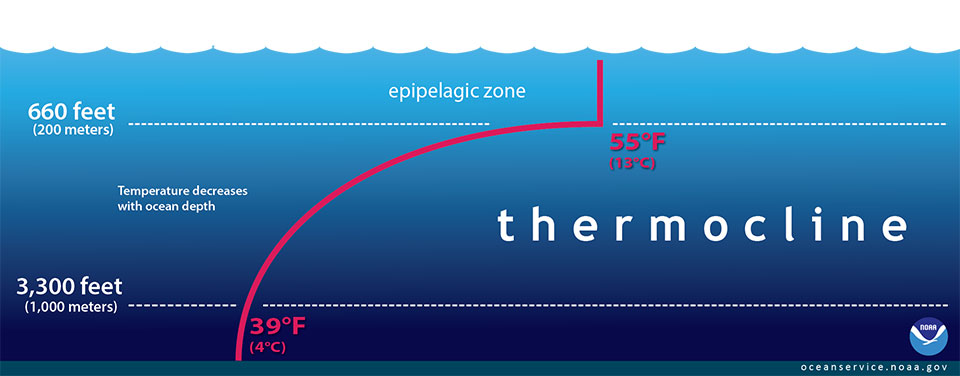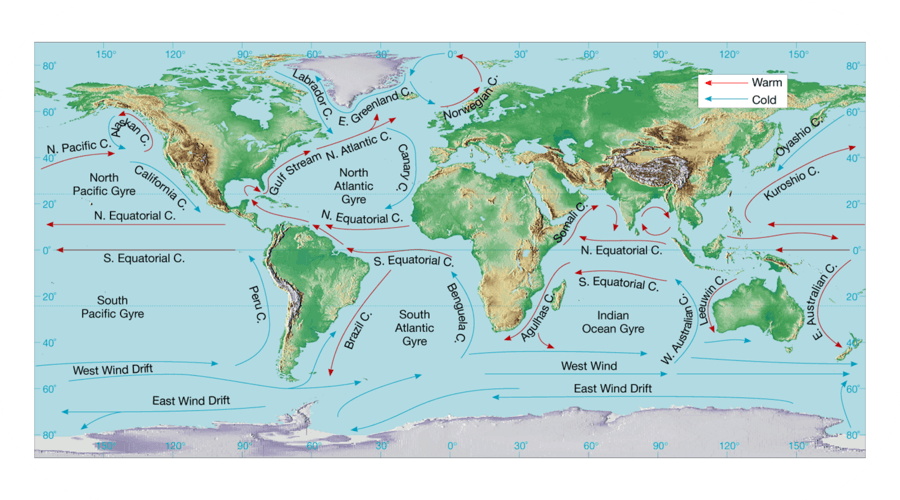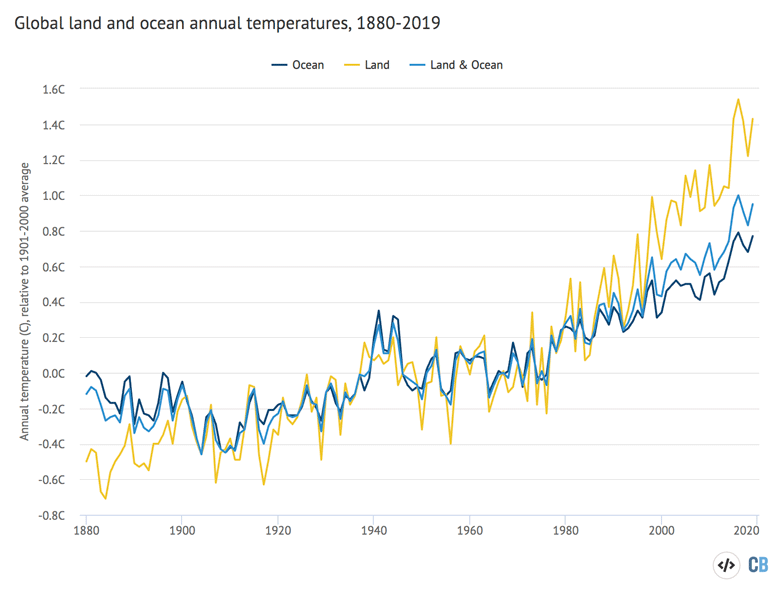What Best Describes the Temperature of the Oceans Surface
-Hence higher altitudes usually have the coldest waters. Which statement best describes the temperature of the oceans surface water.

The Difference Between Evaporation And Condensation And Their Importance In Creating Weather Events Evaporation Weather And Climate Condensation
-These variations in solar energy mean that the ocean surface can vary in temperature from a warm 30C 86F in the tropics to a very cold -2C 28F near the poles.

. This temperature directly or indirectly impacts the rate of all physical chemical and most biological processes occurring in the ocean. The falling of global sea levels D. Which point on the map has a colder climate because of the proximity to an ocean current.
Areas with high density have the warmest water. The surface temperature of the worlds oceans varies mainly with latitude with the warmest waters generally near the equator and the coldest waters in the Arctic and Antarctic regions. Postal Service to create a Forever international rate stamp released on Earth Day in 2014.
Fairly steady with a. A simulation of sea-surface temperatures from the Geophysical Fluid Dynamics Laboratory. Areas close to the equator have the coldest water.
Areas with a low salinity have the coldest water. Areas with a low density have the coldest water. The surface current can be found in the upper 400 meters in the water.
Which best describes a factor that is the same for the different layers of oceans. Oceans cover about 70 of the surface of the earth and form layers based on water depth. Bodies of water are made up of layers determined by temperature.
Areas close to the equator have the coldest water. Look at the diagram of sea-surface temperatures. Oceans - Part 1.
Because the ocean covers 71 percent of Earths surface scientists record. Which statement best describes how the temperature of the oceans surface water varies. B areas with high density have the warmest water.
This model inspired the US. More warming in the Northern Hemisphere than in the Southern Hemisphere E. Question 5 30 seconds Q.
In the ocean solar energy is reflected in the upper surface or rapidly absorbed with depth meaning that the deeper into the ocean you descend the less sunlight there is. Middle School answered Which statement best describes how the temperature of the oceans surface water varies 2. This particular bullet point will explain the surface current first.
Which statement best describes how the temperature of the oceans surface water varies - 2845811. 2 question Which statement best describes the temperature of the oceans surface water. Areas of high salinity have the coldest water.
Areas with low density have the coldest water. Areas with a low density have the coldest water. There are two types of ocean currents which are surface currents and deepwater currents.
The surface current is equal to 10 of all water in the ocean. Sea surface temperature rainfalla. Areas at high latitudes have the coldest water.
This results in less warming of the water. Which statement best describes how the temperature of the oceans surface water varies. Areas at high latitudes have the coldest water.
During an el niñosouthern oscillation event which of the following best describes conditions in the eastern part of the tropical pacific ocean e. Which statement best describes the temperature of the oceans surface water. Fairly steady temperatures until recently C.
At depths below 13100 feet the temperature ranges from near freezing to just above the freezing point of water as depth increases. Plz guys 14 points. 1 on a question.
Therefore the deep ocean below about 200 meters depth is cold with an average temperature of only 4C 39F. A areas close to the poles have the warmest water. In which of the following areas would you expect to find the highest salinity.
Which phrase best describes the earths average surface temperature for the past 900000 years. G near peru and ecuador. Areas close to the poles have the warmest water C.
Answer choices Areas at high latitudes have the coldest water. Warm surface currents invariably flow from the tropics to the higher latitudes driven mainly by atmospheric winds as well as the earths rotation. An earth warmer than at any time in the last 10000 years C.
Which statement best describes the temperature of the oceans surface water. Areas with a high salinity have the coldest water. SST is globally monitored by sensors on satellites buoys ships ocean reference stations autonomous.
C areas at high latitudes have the coldest water d areas with a low salinity have the coldest water and only answer if you are. Areas with a high density have the warmest water. Which statement best describes how El Niño affects precipitation in the southwestern United States.
Sea surface temperature provides fundamental information on the global climate system. Prolonged periods of cooling and warming D. Which statement best describes how the temperature of the oceans surface water varies.
Which statement best describes how the temperature of the oceans surface water varies. Earth Science - 208 Mid-Unit Test. A 24 to 54 degree centigrade rise in earths mean surface temperature by 2100 B.
Human responsibility for the changes in temperature. Areas with a high salinity have the coldest water. Areas at high altitude have the coldest water D.
Fairly steady with occasional cool spells E. These winds help the atmosphere and ocean to move heat around the world. Areas with a low salinity have the coldest water B.
Areas close to the poles have the warmest water. Sea surface temperature SST is defined as the temperature of the top few millimeters of the ocean. And salt water has an even higher one so the temperatures of the oceans remain within a small range because As the heat rises you.
At high latitudesocean waters receive less sunlight the poles receive only 40 percent of the heat that the equator does. As the oceans absorb more heat sea surface temperature increases and the ocean circulation patterns that transport warm and cold water around the globe change. The top surface layer is called the epipelagic zone and is sometimes referred to as the ocean skin or sunlight zone.
The winds drive an ocean circulation transporting warm water to the poles along the sea surface. A steady warming trend B. Warm ocean surface temperatures increase convection thereby increasing rainfall.
Areas at high latitudes have the coldest water. Which of the following has a definite pattern of variation with respect to latitude.

Illustration Of The Energy Balance Between Earth S Surface And The Atmosphere Green Energy Solar Renewable Solar Advantages Of Solar Energy

Solar Power Drives Earth S Climate Energy From The Sun Heats The Surface Warms The Atmosphere And Powers T Renewable Solar Solar Energy What Is Solar Energy

Hydrosphere Review Earth Sciences Quiz Quizizz

Global Climate Change Explorer Oceans And Water Exploratorium

Guest Post Why Does Land Warm Up Faster Than The Oceans

Ocean Currents Science Quiz Quizizz

Ocean Layers Mixing Time Scavengers

Global Climate Change Explorer Oceans And Water Exploratorium

Advantages Of Global Warming Is There An Upside To Climate Change Global Warming Effects Of Global Warming Climate Change

Surface Currents Physical Geography
Climate Science Investigations South Florida Temperature Over Time

Global Climate Change Explorer Oceans And Water Exploratorium

6 2 Temperature Introduction To Oceanography

Pf Hydrosphere Science Quiz Quizizz



